
Forty Years ago in the X-15 Flight Test Program, September - November 1961 |
The NB-52B had not launched an X-15 since flight 2-14-28 on March 30.
Captain Jack Allavie and RAF Squadron Leader Harry Archer had launched Commander Forrest Petersen in X-15-1 from the NB-52A on August 10. A month passed before the next X-15 flight, but then the pace of the program picked up considerably.
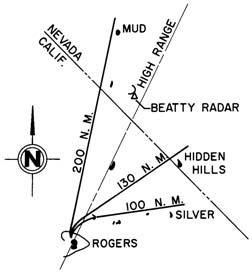 The choice of launch
lake was determined by the distance that the X-15 would fly on a
planned flight profile. Faster flights required the X-15 to be
launched farther from Edwards Air Force Base.
The choice of launch
lake was determined by the distance that the X-15 would fly on a
planned flight profile. Faster flights required the X-15 to be
launched farther from Edwards Air Force Base.
On September 12, 1961 the recently promoted Major Jack Allavie and RAF Squadron Leader Harry Archer piloted the NB-52B with the X-15-2 mounted on the wing. Jack Russell manned the launch panel operator's station. Joe Walker was the X-15 pilot for the eighteenth flight of the X-15-2.
Walker triggered the X-15 launch mechanism over Mud Lake, Nevada. The X-15-2 dropped away from the NB-52B and accelerated to 3,618 miles per hour at engine burnout. It was the fastest velocity achieved by the X-15 so far, but due to atmospheric conditions, the maximum Mach number attained was 5.21, which was slightly less than that achieved by Major White on mission 2-17-33 on June 23. The maximum altitude of mission 2-18-34 was 114,300 feet.
 X-15-2 on the wing of the NB-52A. Photo courtesy NASA Dryden.
X-15-2 on the wing of the NB-52A. Photo courtesy NASA Dryden.
On September 28, Major Allavie and RAF Squadron Leader Archer flew the NB-52B with the X-15-2 to Hidden Hills Lake. They launched Commander Forrest Petersen on mission 2-19-35. Petersen's highest speed was 3,600 miles per hour, slightly less than the speed that Joe Walker had achieved on the previous flight. Due to atmospheric conditions, Petersen reached a new record Mach number of 5.3. at a slightly lower maximum altitude of 101,800 feet.
The stability of the X-15 was marginal during the descent from high altitude. The problem became more acute as the X-15 achieved progressively higher altitudes. Engineers determined that the stability of the X-15 would be improved during that phase of the flight if the lower portion of the ventral fin were removed.
The next flight of the X-15-1 was flown without the lower portion of the ventral fin to investigate its stability characteristics in that configuration. In a departure from the envelope expansion program, the mission profile called for a lower top speed and altitude than previous flights, so the X-15 was to be launched over Silver Lake.
Major White occupied the co-pilot seat of the NB-52A on September 29 as Major Allavie piloted the first attempt to launch Major Rushworth on the twenty-third flight of the X-15-1. The launch attempt was aborted due to trouble with the X-15's hydraulic system.
Mission 1-23-39 was successfully launched on October 4. Major Allavie and Squadron Leader Archer piloted the NB-52A. Major Rushworth set the X-15's throttle to 50% and let it burn for 120 seconds. The X-15-1 reached a maximum speed of Mach 4.3 (2,830 miles per hour) and the relatively low altitude of 78,000 feet on the first X-15 flight flown without the lower ventral fin.
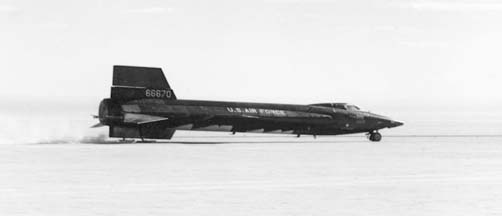 X-15-1 landing on Rogers Dry Lake. Photo courtesy Air Force
Flight Test Center History Office.
X-15-1 landing on Rogers Dry Lake. Photo courtesy Air Force
Flight Test Center History Office.
The twentieth flight of the X-15-2 was aimed at setting a new altitude record. Joe Walker had set the existing record of 169,600 feet during mission 2-14-28 on March 30, 1961. Major White's flight profile called for a maximum speed of Mach 5 and an altitude of 200,000 feet.
Major Jack Allavie and Major Fitzhugh Fulton flew the NB-52A to the launch point over Mud Lake on October 11. After launch, Major White pulled up into a climb of 32 degrees and let the engine burn for 79 seconds. The X-15-2 coasted in a ballistic arc to a new altitude record for the X-15 of 217,000 feet over the north end of Death Valley. It accelerated to a maximum Mach number of 5.21 as it descended over Racetrack Playa.
 As the speed of the X-15-2 dropped
below Mach 2, the outer panel of the left windshield shattered.
Major White reported that the cracked windshield did not
significantly impair his view out of the cockpit.
As the speed of the X-15-2 dropped
below Mach 2, the outer panel of the left windshield shattered.
Major White reported that the cracked windshield did not
significantly impair his view out of the cockpit.
The original soda-lime glass panels of the X-15 cockpit canopy had been replaced with alumino-slicate glass earlier in the program when it was discovered that temperatures on the canopy had been underestimated. It had been anticipated that the windshield gass would be heated by air friction to a temperature of 740 degrees Fahrenheit. On early flights the temperature of the windshield was found to be closer to 1,000 degrees F. The difference in the temperature between the outside surface of the glass and the surface inside the cockpit was 750 degrees F.
After mission 2-20-36 it was determined that the broken windshield pane was a soda-lime glass pane that had inadvertently been re-installed in the canopy.
Joe Walker's objective during the twenty-fourth flight of the X-15-2 was to continue to expand its speed envelope. His flight plan called for him to reach a maximum Mach number of 5.70.
Squadron Leader Archer and Major Allavie launched Walker from the NB-52A over Mud Lake on October 17. Stan Butchart manned the launch panel operator's station. Walker set the X-15's throttle to 100% and pulled up into a climb of slightly more than the 30 degrees called for in the flight plan. Then he pushed the nose down so that he was flying at "zero-G". In other words, his wings were producing no lift, so the X-15 followed a ballistic trajectory. In the cockpit of the X-15, Walker felt nearly three Gs pushing him back into his seat from the acceleration imposed by the XLR-99 engine. The X-15-1 was going Mach 5.74 (3,900 miles per hour) when the engine burned out after 80 seconds. It reached a peak altitude of 108,600 feet during mission 1-24-40.
Major White was scheduled to make the twenty-fifth flight in X-15-1 on October 27. Major Allavie and RAF Squadron Leader Archer took the X-15-1 aloft on the wing of the NB-52A, but the launch attempt was cancelled because of bad weather. A second launch attempt was scheduled for October 31. That launch attempt was postponed to November 1 because the weather was bad.
A Lockheed C-130 was needed for the long range X-15 flights. It carried men and equipment to tend to the X-15 and its pilot in the event of an emergency landing on one of the dry lakebeds under the flight path. Emergency medical technicians would parachute to the locatioin where the pilot came down. On occasion, the C-130 was required for work on other programs, resulting in a postponement of a launch attempt. The November 1 launch attempt was postponed because the C-130 was not available and the weather was still bad.
Major Allavie and Squadron Leader Archer took Major White aloft in the X-15-1 again on November 2, but the X-15 lost cabin pressurization, causing another postponement.
November 3 was a sunny day, and another attempt was made to launch White in the X-15-1. The launch was scrubbed due to a failure of the igniter idle pressure.
Oddly, according to the Dryden Diary, a proposed speed envelope expansion attempt was scheduled for Major White in the X-15-2 for the same day, but it was "cancelled due to weather".
The X-15-1 was removed from the pylon of the NB-52A and efforts were switched to preparing the X-15-2 for an attempt to reach Mach 6. The X-15-1 would not be flown again until the following April.
The X-15-2 was mounted on the wing of the NB-52B for the next launch attempt. A failure to achieve igniter idle pressure resulted in the launch attempt being scrubbed before the NB-52B took off on November 4. An attempt to launch White in the X-15-2 the following day was aborted for the same reason. Another launch attempt was scheduled for November 8, but the X-15-2 suffered auxiliary power unit trouble.
In the meantime, the X-15-1 conducted a successful ground engine run on November 7.
Major John Allavie and Squadron Leader Archer took the X-15-2 aloft under the wing of the NB-52B on November 9.
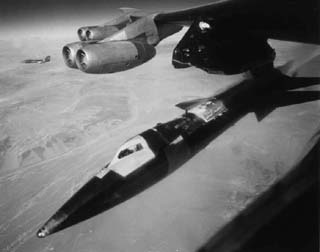 Major White has just triggered the
launch mechanism over Mud Lake. Joe Walker is piloting the
Lockheed F-104 Starfighter that is flying chase off the right
wingtip. Note the curvature of the wing of the B-52 in flight.
Photo courtesy AFFTC/HO.
Major White has just triggered the
launch mechanism over Mud Lake. Joe Walker is piloting the
Lockheed F-104 Starfighter that is flying chase off the right
wingtip. Note the curvature of the wing of the B-52 in flight.
Photo courtesy AFFTC/HO.
A heat resistant paint was tested on the X-15 canopy on the first Mach-6 flight. The left side of the cockpit canopy was painted white. The right side of the canopy remained black.
 The photographer in the rear seat of the
Lockheed F-104 Starfighter that is visible in the picture above
shot this picture at nearly the same moment. The trailing edge of
the Day-Glo orange around the cockpit has been stripped to a
vertical line, revealing part of the blue circle of the nose art.
The 36-inch tall U.S. AIR FORCE lettering has been replaced with
24-inch tall letters. The X-15 mission marks have been stripped
from below the lettering and replaced above the new letters. The
last mission mark on the lowest row represents mission 2-20-36,
which was flown on October 11. Compare this
photo with one taken in February 1961. Photo courtesy
AFFTC/HO.
The photographer in the rear seat of the
Lockheed F-104 Starfighter that is visible in the picture above
shot this picture at nearly the same moment. The trailing edge of
the Day-Glo orange around the cockpit has been stripped to a
vertical line, revealing part of the blue circle of the nose art.
The 36-inch tall U.S. AIR FORCE lettering has been replaced with
24-inch tall letters. The X-15 mission marks have been stripped
from below the lettering and replaced above the new letters. The
last mission mark on the lowest row represents mission 2-20-36,
which was flown on October 11. Compare this
photo with one taken in February 1961. Photo courtesy
AFFTC/HO.
At full throttle, Major White pulled up to a climb angle of twenty-five degrees and then pushed over for a zero-G acceleration run over the north end of Death Valley. The X-15-2 was going Mach 6.04 (4,093 miles per hour) when the engine burned out 83 seconds after launch. The maximum altitude on mission 2-21-37 was 101,600 feet.
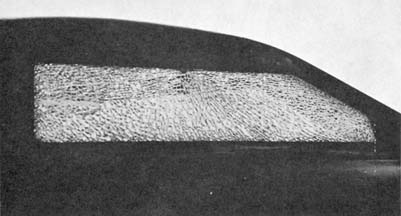 For the second time in a month, one
of the multiple panes of glass in the window of the cockpit
shattered while Major White was flying the X-15. This time it was
the window on the right side of the cockpit canopy, which lacked
the heat resistant paint, that failed.
For the second time in a month, one
of the multiple panes of glass in the window of the cockpit
shattered while Major White was flying the X-15. This time it was
the window on the right side of the cockpit canopy, which lacked
the heat resistant paint, that failed.
The alumino-silicate glass fractured into much smaller pieces than the soda-lime glass window that had failed on mission 2-20-36. The view through that side of the canopy was comletely obliterated. If the window on the other side of the cockpit had broken, White would have had no visibility out of the cockpit. His only option would have been to fly on instruments until the approach to landing. Then he would have had to jettison the cockpit canopy and try to land the X-15 with an open cockpit.
Air friction heating of the Inconel-X window frame had caused the frame to buckle. The deformation of the frame caused it to pinch the glass panes. When the frame pressed in on the glass, conduction of heat from the frame caused that part of the window to expand more than the surrounding glass . Thermal stresses shattered the outer pane of the cockpit window. The glass stayed in place, but the view through the window on that side of the cockpit was obliterated. The problem of cockpit windows breaking in flight was solved by replacing the 0.05 inch thick Inconel X window retaining frame with a 0.10 inch thick titanium frame to eliminate the buckling of the frame.
This flight concluded the speed envelope expansion for the X-15 in its original configuration. It had achieved the Mach number set as the goal for the program nearly a decade earlier. The speed achieved on this flight would not be exceeded by an X-15 again for over two years.
In the course of the last five X-15 flights, the maximum Mach number had been increased three times and a new altitude record had been established. The only flight that did not set a record was flown to evaluate the stability of the X-15 with the lower ventral fin removed.
The movie X-15 premiered in Hollywood over the Veteran's Day weekend. Staff from the Flight Research Center attended a screening on Friday November 10.
Link to the Internet Movie Database page for the movie X-15.
The X-15-2 would not fly again for five months. Attention was centered on the preparation of the X-15-3 for its long delayed first flight in December.
 Books about
Edwards Air Force Base and the X-15 available from
Books about
Edwards Air Force Base and the X-15 available from 
 At the Edge of Space : The X-15 Flight Program
by Milton O. Thompson. The story of test flying the X-15 from the
point of view of the pilot.
At the Edge of Space : The X-15 Flight Program
by Milton O. Thompson. The story of test flying the X-15 from the
point of view of the pilot.
 Angle of Attack : Harrison Storms and the Race to
the Moon by Mike Gray. The biography of Harrison Storms, who
was instrumental in the development and operation of the X-15.
Angle of Attack : Harrison Storms and the Race to
the Moon by Mike Gray. The biography of Harrison Storms, who
was instrumental in the development and operation of the X-15.
 X-15 (The Nasa Mission Reports)
X-15 (The Nasa Mission Reports)
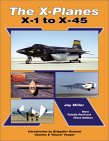 The X-Planes: X-1 to X-45: 3rd Edition
by Jay Miller
The X-Planes: X-1 to X-45: 3rd Edition
by Jay Miller
 Test Colors: The Aircraft of Muroc Army Airfield
and Edwards Air Force Base by Rene Francillon
Test Colors: The Aircraft of Muroc Army Airfield
and Edwards Air Force Base by Rene Francillon
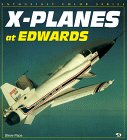 X-Planes at Edwards (Enthusiast Color
Series) by
Steve Pace
X-Planes at Edwards (Enthusiast Color
Series) by
Steve Pace
 Edwards Air Force Base : Open House at the USAF
Flight Test Center 1957-1966 : A Photo Chronicle of
Aircraft Displayed (Schiffer Military History) by Robert D. Archer
Edwards Air Force Base : Open House at the USAF
Flight Test Center 1957-1966 : A Photo Chronicle of
Aircraft Displayed (Schiffer Military History) by Robert D. Archer
*The first position of the mission number identifies which X-15 was involved, the second number indicates how many times that X-15 had been launched, and the third number indicates how many times it had been carried by an NB-52.
Send a message to Brian
Go to home page of the Goleta Air & Space Museum.